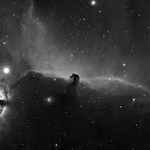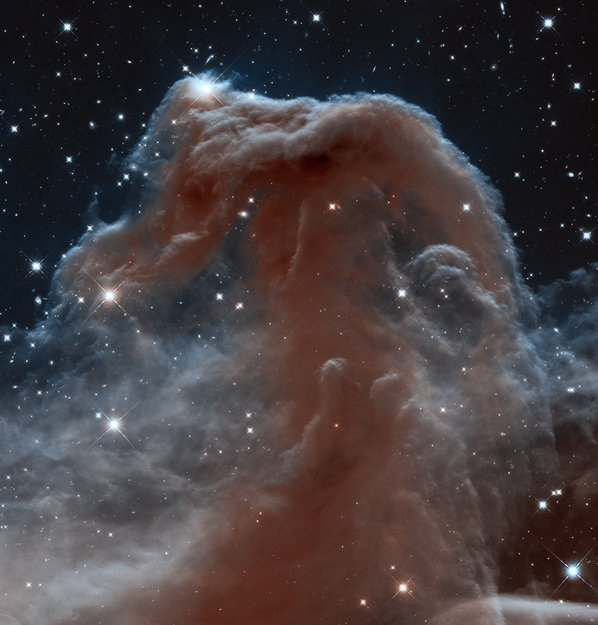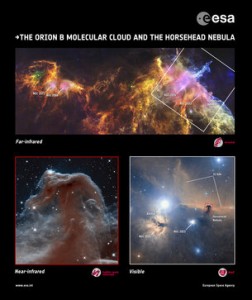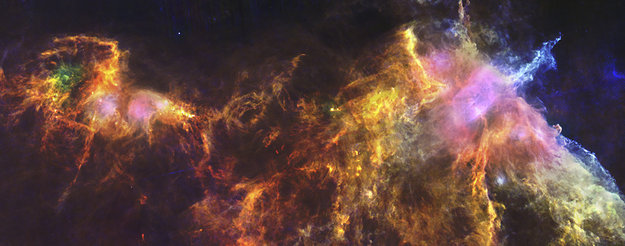A new image from the Herschel Space Telescope with an assist from the Hubble in near infrared reveals details previoulsy unseen in traditional optical wavelengths. First a little history of this amazing object followed by some gorgeous images.
The Horsehead Nebula was first seen by Williamina Paton Stevens Fleming (May 15, 1857 – May 21, 1911) a pioneering female astronomer who began her career as a maid at the Cambridge, Massachusetts home home of astronomer Edward Charles Pickering in 180. Legend has it Pickering, working at the nearby Havard Observatory, was frustrated one day with his male assistants and declared “My maid could do a better job” and set out to prove it.
Fleming was brought in, initially to do clerical work, and her organizational ability and quick mind was quickly set to work classifying objects and features of interest. She devised a system in which stars were group according to how much hydrogen was visible in their spectra. The most she classed as “A-type “B-type” and so on. This system was later tweaked by another female star-gazer and become the now familiar system used by astronomers to this day, i.e., O, B, A, F, G, K, M, L, T, and sometimes Y. That system is still used today, from brilliant blue-white O stars to the Y class brown dwarfs. They are further subdivided into numeral grades. In this scheme our sun rates as G-2 yellow star. The concept of the Main Sequences and Hertzprung-Russel diagram was developed and refined and forms the basis of stellar taxonomy to this day.
 During the next few years Fleming most of her hearing due to an outbreak of Scarlet fever. Perhaps deprive of the ability to easily socialize or enjoy music, she turned her attention to the visual pleases of astronomy and graduated with a degree in physics. She soon became fascinated by the emerging art of photography and was integral in producing and analysing some the highest quality stellar photographs in the world. It was on one of the early photos, plate B2312, that Fleming described “a semicircular indentation 5 minutes in diameter 30 minutes south of Zeta [Orionis].” The object was soon nicknamed the Horsehead Nebula because in early images it superficially resembled a horse’s head. Shown right is either that very image or one very like it.
During the next few years Fleming most of her hearing due to an outbreak of Scarlet fever. Perhaps deprive of the ability to easily socialize or enjoy music, she turned her attention to the visual pleases of astronomy and graduated with a degree in physics. She soon became fascinated by the emerging art of photography and was integral in producing and analysing some the highest quality stellar photographs in the world. It was on one of the early photos, plate B2312, that Fleming described “a semicircular indentation 5 minutes in diameter 30 minutes south of Zeta [Orionis].” The object was soon nicknamed the Horsehead Nebula because in early images it superficially resembled a horse’s head. Shown right is either that very image or one very like it.
Fleming went to discover dozens of nebula, stars, and even supernova. She was among the fist generation of women astronomers, she was the first American women to join the Royal Astronomy Society of London. Williamina Fleming died in 1906 from complications of pnemonia at the age of 64. If only she could see her nebula the way we can see it today through the Hubble Space Telescope.

 Had Fleming seen it like that, she and her peers might have nicknamed it the psychedelic mushroom nebula or something. One of the problems with nebula in general is we could only see them in visible light for the better part of a century. Gas and dust ot=ften occlude features we would like to see embedded deep inside the nebula, features critical to understand when trying to figure out what kind of denizen the nebula is or started out as.
Had Fleming seen it like that, she and her peers might have nicknamed it the psychedelic mushroom nebula or something. One of the problems with nebula in general is we could only see them in visible light for the better part of a century. Gas and dust ot=ften occlude features we would like to see embedded deep inside the nebula, features critical to understand when trying to figure out what kind of denizen the nebula is or started out as.
That’s where the Herschel Space Telescope comes in. The Hersh sees in deeper infrared than Hubble and can thus ne used to accentuate and highlight Hubble data, forming a combo image sure to delight viewers with its lacy, colorful detail. Here’s the Horsehead complex combined into a single wide-field image as seen by those two powerful lights.
The Horsehead is that little bitty pimple on the far right about halfway up.


Simply stunning and beautiful.
Well-phrased and carefully investigated questions lead to answers which themselves contain additional questions. This is grand fun!
Just – WOW! I need a bigger telescope :(
… Williamina Paton Stevens Fleming (May 15, 1857 – May 21, 1911) … Williamina Fleming died in 1906 from complications of pnemonia at the age of 64.
None of these numbers match up.
[/pedant]
Thanks for passing along these beautiful images!
@markr1957:
Not necessarily.
Just getting rid of our pesky atmosphere — and learning to see into the deep infrared — would accomplish much of what you seek.
How big a balloon, and how much helium, can you put your hands on?
Happy seeing!
Superluminously magnificant images here. Cheers Stephen “DarkSyde” Andrew.
@ 4.Pierce R. Butler
Wikipedia :
http://en.wikipedia.org/wiki/Williamina_Fleming
confirms the birth and death dates but has Williamina Fleming’s age at death as 54 not 64. Which arithmatic says is correct assuming the 1911 date of death is correct. Had W. Fleming died in 1906 she’d have been a year shy of her 40th birthday and had she died in 1921 she’d have been 64. Flipping through a few books has failed to confirm or refute any of this info. The wiki link to her bio gives an error reading and seems to be a broken.